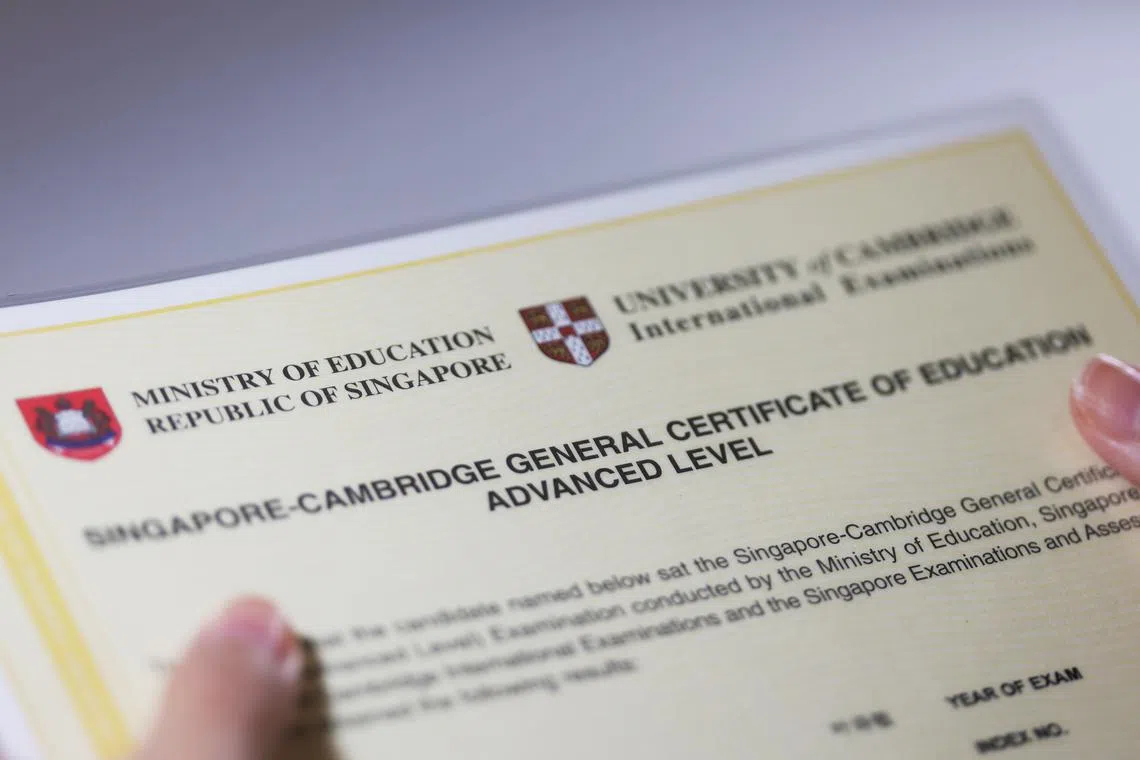askST: More S’pore university places likely for fresh school-leavers and adult learners in 2025
With the university admissions exercise in full swing, students and their parents are asking if more degree places will be offered this year, and what the chances are of polytechnic graduates earning a berth in the six universities.
Sign up now: Get tips on how to grow your career and money

Around four in five A-level and IB graduates currently progress to the autonomous universities, up from around three in four in 2015.
PHOTO: LIANHE ZAOBAO
Follow topic:
Q: With the Government promising to increase the cohort participation rate to 60 per cent by 2025, can we expect publicly funded universities to offer more places in 2025 than in 2024?
A: Figures from the Ministry of Education (MOE) show that 18,500 A-level graduates, International Baccalaureate (IB) diploma holders and polytechnic diploma graduates were offered undergraduate places in the six local universities in 2024.
The number of places was similar to that in 2023, but the good news is that the percentage of eligible applicants given places – known as the cohort participation rate – went up from 42.9 per cent in 2023 to 43.9 per cent in 2024. According to the Budget Book, it is estimated to go up further to 45 per cent in 2025.
But the demand for university places remains high, with around 36,800 school-leavers (Singapore citizens/permanent residents) applying to full-time undergraduate programmes in the six universities in 2024.
This translates to about two applicants for every university place.
The Government’s promise that 60 per cent of the cohort would be in degree programmes by 2025 refers to the lifetime cohort participation rate and includes places given to adult learners enrolling in various degree pathways, including part-time and work-study degree programmes.
MOE told The Straits Times it is working closely with the institutes of higher learning to increase the number of publicly funded university places for adult learners.
Thus far, the target has been courses related to growth sectors in the economy. These include areas related to Stem (science, technology, engineering and mathematics), as well as non-Stem sectors such as social services and other roles in the care economy.
The universities have introduced new degree innovations, such as the Singapore Institute of Technology’s (SIT) Competency-based Stackable Micro-credential pathway, which allows working adults to pursue degrees by accumulating micro-credentials – industry- or institution-recognised certifications that focus on specific skills and competencies.
Some also offer part-time work-study degree programmes that involve companies co-designing and delivering the curriculum. Examples are the Singapore University of Social Sciences’ (SUSS) Bachelor of Early Childhood Education and Nanyang Technological University’s (NTU) Part-Time Work-Study Degree in Computing.
MOE said it will provide an update on the lifetime cohort participation rate by late 2026, as some of the AY2025 intake will occur only in early 2026.
Here are the intake figures for the six universities in 2024, which include Singapore citizens, permanent residents and international students:
National University of Singapore: 7,308
Nanyang Technological University: 6,501
Singapore Management University: 2,380
Singapore University of Technology and Design: 494
Singapore Institute of Technology: 3,381
Singapore University of Social Sciences: 1,117
Q: How many polytechnic graduates landed places in local universities in 2024? How does the number compare to those coming out of junior colleges and Integrated Programme schools?
A: According to the ministry, around 8,000 polytechnic graduates were admitted to the six universities in 2024 as full-time undergraduates, making up more than 40 per cent of the intake of 18,500 Singapore citizens and permanent residents.
This translates to around one in three fresh polytechnic graduates entering the universities, up from around one in four in 2015.
Around four in five A-level and IB graduates currently progress to the autonomous universities, up from around three in four in 2015.
Most new university places created over the last 10 years, including those at SUSS and SIT, went to polytechnic diploma holders.
Those two universities cater more to polytechnic graduates – not just in their applied learning approach, but also in their degree offerings, which are aligned with the diploma programmes offered by the five polytechnics.
A change that also favours polytechnic graduates is the move to aptitude-based admissions, in which universities look beyond grades and at the aptitude and talent of applicants.
Q: NUS and NTU have the largest intakes of undergraduates every year, but how many of their students are admitted through aptitude-based admissions? Are the majority still admitted based on their grades alone?
A: Over the years, both the NUS and NTU have cast a wider net to consider more applicants through aptitude-based admissions, in which achievements and talents outside of academics are considered.
The two universities are increasingly employing a broad set of qualitative assessments – including interviews, aptitude tests and portfolios – to assess an applicant’s potential beyond his or her grades.
NTU said it admitted about the same proportion of students through aptitude-based admissions in 2024 as it had in 2023, which was reported to be about 57 per cent of its freshman intake. The university said this was up from about a third of students, or 38 per cent, in 2019.
As in previous years, NUS declined to provide figures on the proportion of its freshmen who were accepted through aptitude-based schemes. It would only say that the number had “increased significantly” compared with six years ago.
Officials from both universities stressed that aptitude-based admissions do not mean that they do not take academic grades into account, as admission dons still look at whether an applicant will be able to handle the rigours of degree studies.
Applicants also have to meet the minimum grades for subjects related to the course of study.


